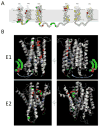Role of flippases, scramblases and transfer proteins in phosphatidylserine subcellular distribution
- PMID: 25284293
- PMCID: PMC4275391
- DOI: 10.1111/tra.12233
Role of flippases, scramblases and transfer proteins in phosphatidylserine subcellular distribution
Abstract
It is well known that lipids are heterogeneously distributed throughout the cell. Most lipid species are synthesized in the endoplasmic reticulum (ER) and then distributed to different cellular locations in order to create the distinct membrane compositions observed in eukaryotes. However, the mechanisms by which specific lipid species are trafficked to and maintained in specific areas of the cell are poorly understood and constitute an active area of research. Of particular interest is the distribution of phosphatidylserine (PS), an anionic lipid that is enriched in the cytosolic leaflet of the plasma membrane. PS transport occurs by both vesicular and non-vesicular routes, with members of the oxysterol-binding protein family (Osh6 and Osh7) recently implicated in the latter route. In addition, the flippase activity of P4-ATPases helps build PS membrane asymmetry by preferentially translocating PS to the cytosolic leaflet. This asymmetric PS distribution can be used as a signaling device by the regulated activation of scramblases, which rapidly expose PS on the extracellular leaflet and play important roles in blood clotting and apoptosis. This review will discuss recent advances made in the study of phospholipid flippases, scramblases and PS-specific lipid transfer proteins, as well as how these proteins contribute to subcellular PS distribution.
Keywords: P-type ATPase; flippase; lipid transfer protein; membrane asymmetry; phosphatidylserine; scramblase.
© 2014 John Wiley & Sons A/S. Published by John Wiley & Sons Ltd.
Figures



References
-
- Bell RM, Ballas LM, Coleman RA. Lipid topogenesis. J Lipid Res. 1981 Mar 1;22(3):391–403. - PubMed
-
- Zinser E, Daum G. Isolation and biochemical characterization of organelles from the yeast, Saccharomyces cerevisiae. Yeast. 1995 May 1;11(6):493–536. - PubMed
-
- Bretscher MS. Membrane Structure: Some General Principles. Science. 1973 Aug 17;181(4100):622–9. - PubMed
Publication types
MeSH terms
Substances
Grants and funding
LinkOut - more resources
Full Text Sources
Other Literature Sources

